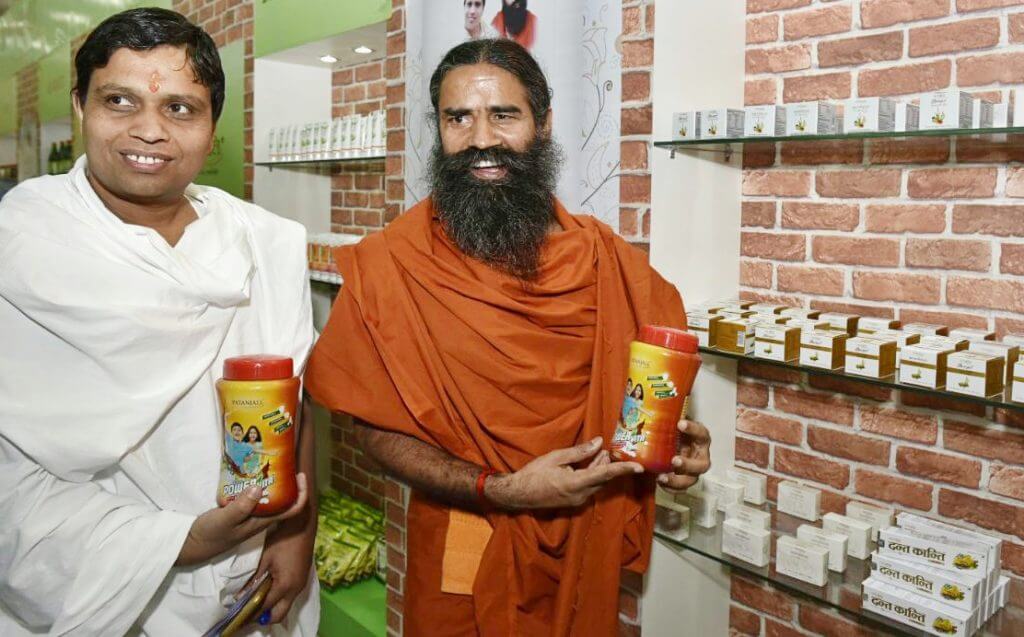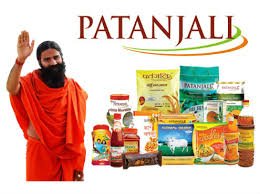
How Patanjali Brand was born?
In 1995, Baba Ramdev was an unknown yoga teacher in Haridwar when he and his close associate, Acharya Balkrishna set up Divya Pharmacy to make Ayurvedic and herbal medicines. The medicines became so popular that they sought to scale and diversify into other products. But that turned out to be difficult since Divya Pharmacy was registered under a trust.
At the same time, Baba Ramdev’s popularity began to rise as a yoga brand, substantial funds began to come in – sizeable loans from NRIs like Sarwan and Sunita Poddar, as well as locals such as Govind Agarwal – which in turn helped to get bank loans. Thus was born Patanjali Ayurved as a private company in 2006, which has since rolled out a range of products in 4 business divisions home care, cosmetics and health, food and beverages, and health. Today, Balkrishna is among the richest men in India and Patanjali a 10,000 crore brand in the Indian fast-moving consumer goods (FMCG) sector. While Ramdev creates markets by propagating Yoga and Ayurveda, Balkrishna creates the products. Their partnership has been phenomenal, but there are also many other reasons behind the success story of Baba Ramdev’s Patanjali brand
Baba Ramdev’s Patanjali Brand-The Growth Factors
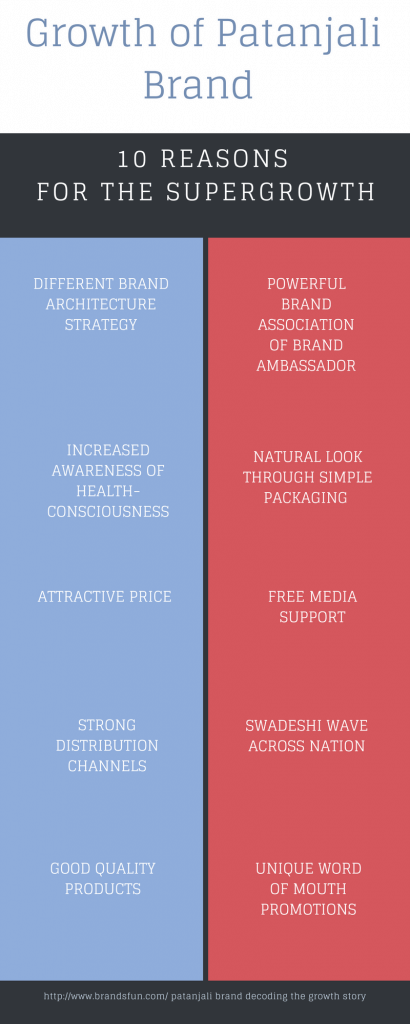
1.Different Brand Architecture Strategy :Baba Ramdev’s Patanjali brand follows a ‘Branded House’ strategy whereas other companies in the consumer goods sector like P&G and HUL follow a ‘House of Brands’ strategy. That ws the great start point for a new brand as advertising & communication costs are much lesser in this kind of strategy
2.Increased Awareness of health-consciousness: There has been a shift in customer behaviour towards healthy & natural ayurvedic products. This is evident from the fact that huge investments are done today in organic and Ayurvedic products. According to Nielsen, the health and wellness segment is now Rs. 33,000 crore and grew 6% over 2014. Patanjali, with its Ayurvedic product line, has capitalised on this shift in consumer behaviour and hence could capture more market share.
3.Attractive Price :Baba Ramdev’s Patanjali brand products are available at competitive prices as compared to their competition. Patanjali products are sourced directly from farmers and no middlemen are involved. So raw material procurement cost is reduced and production of goods happen at a much cheaper price. Patanjali is now making 20% operating profit which is higher than the industry average.
4.Strong distribution channels:Patanjali products are sold through three types of medical centers. These include Patanjali Chikitsalayas which are basically clinics. Then there are Patanjali Arogya Kendras which are health and wellness centers. They also have non-medicine outlets called Swadeshi Kendras. The group has 15,000 exclusive outlets across India. They also distribute through general retail stores. As mentioned above, they have also tied up with big retail chains like Big Bazaar. Baba Ramdev’s Patanjali brand plans to grow to 1,00,000 outlets in the next few years.
5: Strong Brand Association:Patanjali has able to create brandperception of health and wellness among the Indian masses,primarily because of Baba Ramdev’s association with the brand.Hence, more people are attracted to Patanjali’s products and repeat purchases are happening.
6.Simple packaging, that gives it a ‘natural’ look: Patanjali sells its products with a very simple packaging. While you may feel that it is not a good strategy but the truth is it is working for Patanjali. Here the message is to promote ‘Ayurveda’ and ‘Health’, simple packaging can be a very effective way of promotion.With a ‘natural’ look ( leaves and herbs), there is an imagery of health and wellness to attract the customer.
7.Free Media promotions:Baba Ramdev has the image of being a veteran guru of yoga across the globe. He has a very good network inside press and media has been their darling with his press releases. Also, he has good connections with many politicians. He uses his network effectively to promote Patanjali. Baba Ramdev approached Lalu Prasad Yadav and gave him a face massage with a Patanjali face cream to generate a lot of PR. During the Maggi scandal, Baba Ramdev gave a statement that he would launch safer and good quality noodles generating free publicity.
8.Swadeshi Factor: The X Factor is the Swadeshi wave that has been unleashed as part of the BJP government in power. There has been an overall emphasis on nationalism & Patanjali and other desibrands stand to benefit from the wave.In a Crowded category like FMCG flooded & dominated by foreign players, a desi player getting his product right has a distinct advantage
9.Word-of-mouth promotion:Advertising typically account for 12-20% of revenue expenditure by FMCG companies. In the case of a new entrant, this spending is significantly higher. In the introduction stage, Patanjali followed a unique word-of-mouth publicity model and the entire revenue was without any advertising. It was because of the brand loyalty of its customers that the word-of-mouth promotion proved so successful for the company.
10.Unique Advertising Media Mix: Baba RamDev’s Patanjali brand was third best advertiser in Nov 2016 behind Cadbury and Fair & lovely.They followed a unique strategy of putting up ads in News channels to bring in large scale in advertising.The strategy was to bring in pull in the trading community who uses the genre of television news rather than the traditional FMCG strategy of using daily soaps & movies to sell products.
11.Good Quality: My personal experience with the brand tells me that the overall quality of products is mostly in line with other players & many cases much better. This along with natural factor has led to effective word of mouth for the brand
Patanjali Revenue Figures & Way forward:
Revenue figures of the brand are very impressive & they have grown multi-fold as can be gauged from below chart.
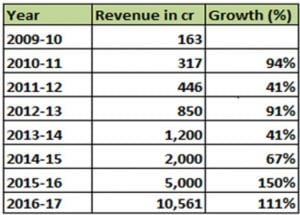
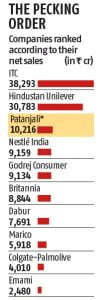
Patanjali Ayurved has grown exponentially in the last five years. While the growth rate for most FMCG companies ranged between eight and 12 per cent during this period, Patanjali’s revenue multiplied by over 20 times – from Rs 453.4 crore in 2011-12 to Rs 9,346 crore in 2016-17.They have grown to 10,000 crore brand already.This means they have surpassed Colgate who have been in business for eight decades while Patanjali has been around for 8 years. Its revenue continued to grow in triple digits even during the past two years, when all its peers witnessed muted growth owing to general slowdown.
The Patantaji group’s total sales touched Rs 10,561 crore during 2016-17, with its FMCG business, Patanjali Ayurved, posting revenue of Rs 9,346 crore; the ayurvedic and herbal medicines business, Divya Yog Pharmacy, contributing Rs 870 crore; and Patanjali Gramodyog Nyas, a trust that works in the fields of animal husbandry and economic and social uplift of villagers, generating Rs 345 crore.
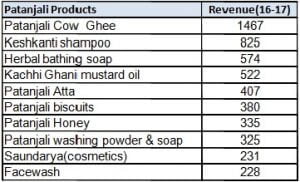
Patanjali Cowghee remains most sold product generating Rs 1500 Cr while shampoo generates around 800 crores followed by bathing soap, mustard oil, atta.Patanjali biscuits & honey has also started driving good revenue for the company.
Currently, Patanjali holds a 15 per cent share in the domestic shampoo market. Its market share in toothpaste and honey businesses is about 14 per cent and 50 per cent, according to Ramdev. The firm had ventured into the personal beauty and cosmetics market early last year with its Saundarya brand, which contributed Rs 231 crore to its top line, while its facewash business grabbed a 35 per cent market share with sales worth Rs 228 crore. Its skin care business clocked Rs 231 crore.
Patanjali Ayurved plans to increase its distribution network in 2016-17. To meet its stated target for the current year, Patanjali will be investing Rs 5,000 crore in five new food parks in Madhya Pradesh, Maharashtra, Andhra Pradesh, Assam, and Uttar Pradesh.Patanjali, which currently employs 100,000 people, will take that number to 500,000 in the next one year, Ramdev said.
“This is just the beginning. Nestle, Hindustan Unilever and Colgate- Palmolive will be left clueless eventually,” Baba Ramdev said.
Baba Ramdev’s Patanjali Brand-Way Forward
- Strengthen their distribution channels:The key to success in FMCG is the distribution channel. Patanjali should ensure its products are available everywhere and at any time. it should tie up with other key retail chains/stores and make its presence felt.Already there has been instances of HUL going full throttle with revamped new Ayush brand
- Avoid falling into the ‘Icarus Paradox’: Icarus Paradox, “It is the phenomenon of businesses failing abruptly after a period of apparent success, where failure is brought about by the very elements that led to their initial success”. Patanjali should ensure innovation in the products & evolve along with customer behaviour
- Focus on quality:Quality is of prime importance in FMCG products.In order to succeed, Patanjali should ensure to maintain the same level of quality in future as well. Overall scale will increase due to demand & how they manage the tradeoff will be a huge factor
Conclusion
Baba Ramdev’s Patanjali brand has disrupted the whole FMCG sector and bought a revolution in the industry in a very short span of time. A point to note is that many people are buying Patanjali is attracting brand-loyal customers and not price-sensitive customers.
Will Patanjali manage to grow at the same pace or will it prove to be a water bubble,How will powerful competitors like HUL move against them? Only time will tell.
